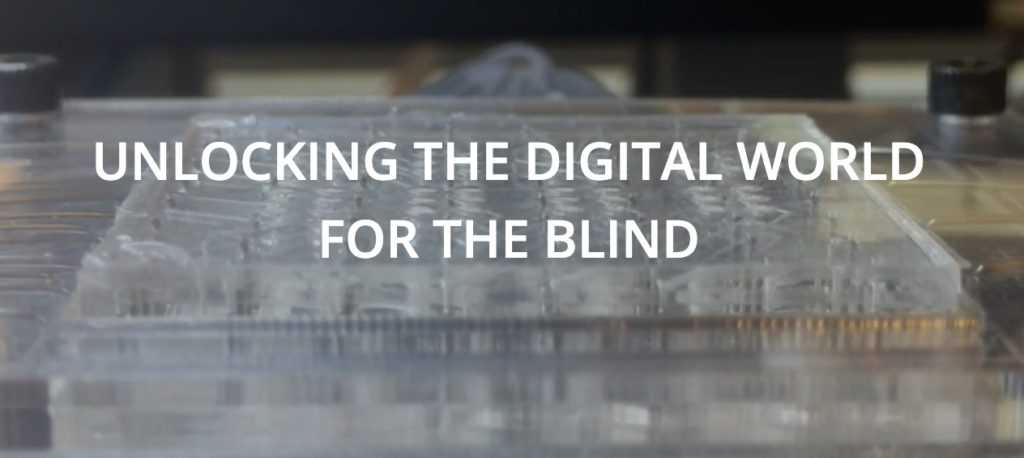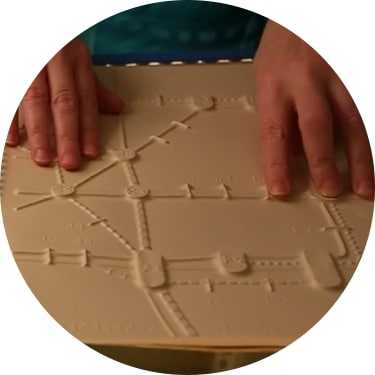engineering, university of michigan
A Better Graphic Tablet for the Blind
By Laura Cowan
Laura K. Cowan is a tech editor and journalist whose work has focused on promoting sustainability initiatives for automotive, green tech, and conscious living media outlets.
Sure, there are braille tablets these days that are pretty amazing. They translate several words or lines of text from websites into raised braille dots on a physical surface that scrolls through the web, opening up the world to those who can't view the content of computers and the internet through traditional screens. But there are challenges. According to Alex Russomanno of new Ann Arbor startup NewHaptics, current braille tablets are limited to small quantities of text at a time, they're incredibly expensive to manufacture, and they don't have any way to translate images or graphs. This leaves the blind locked out of visual content, maps and graphs on computers.
NewHaptics is a newer company out of emerging tech hub Ann Arbor in the Midwest, and they have a very special product coming to market. It's a tablet for the blind, which isn't a new idea, but making it affordable to manufacture and capable of representing graphs and visuals on websites is. Alex Russomanno is NewHaptics' CEO, and a recent graduate of the University of Michigan's mechanical engineering PhD program. He says that when he was studying at the University of Michigan, he worked with U of M Associate Professor of Information Science Sile O'Modhrain and Professor of Mechanical Engineering Brent Gillespie, who teamed up with Russomanno to found NewHaptics after his graduation.
"The beginnings of the company started as a research project when I was at the University of Michigan," Russomanno tells us. "My advisors, one who is blind, were both experts in haptics. The idea was to make graphic information more accessible like we access data visually day to day."
The real challenge wasn't to invent a new technology, but to find a way to unhook that ratio of controllers to dots raised on the surface of a tablet. However the technology works, from raised pins to bubbles being pushed up by tiny solanoids, having one controller to every dot is very expensive in scaling up manufacturing. Tablets produced this way are made essentially as one-offs, as they can cost $20,000-$40,000 apiece to make.
"We're hoping to do several lines of text plus a pixelated surface to allow people to interact with spatial information," Russomanno explains. As NewHaptics has found ways to allow single controllers to control multiple dots on a tablet's surface, it has cheapened manufacturing and allowed them to create larger screens that fit more information.
"Blind people have been wanting this for decades," Russomanno says. "It's not a new idea, but the underlying tech is difficult, to raise multiple pins in a small area."
The technology NewHaptics is using is called microfluidics, which raises bubble membranes under air pressure as dots on a tablet's surface. "We manufacture the minimum number of components that are needed to control the tech," Russomanno says, which keeps costs and complexity down. "Typically, an electronic valve ports air to a bubble. The way we're able to achieve scalability is to allow one of these ports to control multiple bubbles."
We can't wait to see this tech in action. Russomanno says that braille has been such a bulky technology for decades that in addition to opening access to visual content, this tablet technology at scale allows blind people to leave behind braille textbooks for learning, which can be so cumbersome that a single textbook can take up an entire shelf of space. Russomanno likens it to technology opening up the world to people in this way: "We've had decades of single lines of braille. Having more could take the blind community from essentially command line to graphic user interface. It would open up so many ways to access digital content. For example, games, the web, and books."
You can see the tiny bubbles in action at NewHaptics' website. For now the fledgling company is working through manufacturing plans and testing, but already has been featured in Wired, NPR, and Popular Science. They are supported by the National Institutes of Health and the National Science Foundation.
alex russomanno, ann arbor tech, braille graphic tablet, braille tablet, michigan tech news, midwest tech news, newhaptics, university of michigan startups




